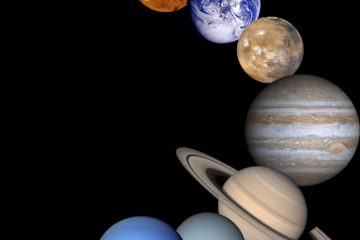Table of Contents
- Understanding the Interconnectedness of Ecosystems Across Our Solar System
- Exploring the Role of Microorganisms in Planetary Health
- Assessing the Impact of Climate Change Beyond Earth
- Innovative Approaches to Planetary Conservation and Resource Management
- Future Challenges: Navigating the Ethics of Space Exploration and Environmental Responsibility
- Q&A
- Key Takeaways

Understanding the Interconnectedness of Ecosystems Across Our Solar System
The concept of ecosystems isn’t confined to Earth; it extends far beyond, suggesting a complex web of interdependence among celestial bodies. Each planet and moon in our solar system hosts unique conditions that influence their potential for life, atmosphere, and geological activity. Understanding how these ecosystems interact can shed light on the dynamics of our own planet as well as help us envision environments where life might exist elsewhere. For example, subsurface oceans detected on moons like Europa and Enceladus might reveal similar life-sustaining qualities that characterize Earth’s own oceans.
Across the solar system, various celestial bodies illustrate different environmental niches that could support life. Some of these include:
- Mars: Once a wet world, its soil and atmosphere might still harbor life.
- Venus: Extreme temperatures and pressure create a hostile yet fascinating environment, raising questions about microbial life.
- Titan: Saturn’s moon, with its methane lakes, presents an ecosystem that operates under completely different biochemistry.
The connections between these ecosystems reveal the potential impacts of solar phenomena, gravitational effects, and chemical exchanges on planetary health. A table summarizing these dynamics can provide insight into how life forms might adapt across environments:
| Celestial Body | Environmental Features | Potential for Life |
|---|---|---|
| Mars | Arid, with polar ice caps and evidence of water flow. | Possibly microbial life; ongoing exploration. |
| Europa | Ice-covered ocean with potential hydrothermal activity. | High potential for simple life forms. |
| Titan | Dense atmosphere, methane lakes. | Unique biochemical possibilities; still a mystery. |
Each planetary body within our solar system contributes to a larger narrative of ecological balance and survival. By exploring the various interactions and characteristics of these environments, we embark on a journey that not only enriches our understanding of potential extraterrestrial life but also deepens our appreciation for the intricate systems that sustain life back on Earth.

Exploring the Role of Microorganisms in Planetary Health
Microorganisms play a pivotal role in maintaining the delicate balance of ecosystems on Earth, influencing everything from soil fertility to climate regulation. These microscopic entities, which include bacteria, fungi, and archaea, are often underestimated despite their profound impact on planetary health. They aid in the decomposition of organic matter, recycling nutrients, and facilitating plant growth, which ultimately supports the entire food web. Understanding the various ways microorganisms contribute to ecosystem resilience and functioning is critical to addressing environmental challenges.
Additionally, microorganisms serve as indicators of environmental change, providing valuable insights into the health of ecosystems. Their diversity reflects the complexity of biological interactions within habitats. For instance, certain microbial communities can signal shifts in nutrient levels, pollution, or climate change. Monitoring these communities can reveal crucial information about ecosystem integrity and help guide conservation efforts. The synergetic relationships between microorganisms and larger organisms, including plants and animals, highlight the interconnectedness of life on Earth, emphasizing that each component, no matter how small, contributes to the larger whole.
To further illustrate the significance of microorganisms, consider the following examples of their key contributions to planetary health:
| Microorganism Type | Role in Ecosystem |
|---|---|
| Bacteria | Fix atmospheric nitrogen, enhancing soil fertility |
| Mycorrhizal Fungi | Facilitate nutrient absorption for plants |
| Decomposers | Break down dead organic matter, recycling nutrients |
| Probiotics in Soil | Promote soil health and plant growth |
These fundamental functions illustrate how microorganisms are not merely inhabitants of the Earth, but active participants in sustaining life. As we continue to explore the influence of these tiny organisms on larger ecological systems, we gain invaluable knowledge that can inform conservation practices, enhance agricultural productivity, and mitigate climate change impacts. In doing so, we not only safeguard the environment but also ensure the well-being of future generations.
Assessing the Impact of Climate Change Beyond Earth
As we explore the universe, it becomes increasingly evident that climate change is not an issue confined to our planet alone. Various celestial bodies exhibit evidence of climate fluctuations that mirror terrestrial phenomena, prompting scientists to reevaluate our understanding of planetary systems. For instance, data from Mars has shown signs of climatic shifts, particularly through its ice caps and dust storms. Similarly, the study of Venus reveals a dense atmosphere with runaway greenhouse conditions, offering valuable insights into potential future scenarios for Earth.
Furthermore, the moons of Jupiter and Saturn present intriguing cases of how environments can evolve over time. Europa, covered in a thick ice shell, may harbor an ocean beneath that could influence its climate and geological activity. Meanwhile, Enceladus showcases geysers that spew water vapor, hinting at a dynamic subsurface environment affected by thermal processes. These examples illustrate that climate dynamics can inform our understanding of potentially habitable environments beyond Earth and the mechanisms driving them.
Research into exoplanets has introduced another layer of complexity to the discussion of climate change. Astronomers have started to identify Earth-like planets within habitable zones, raising questions about their potential climates and ecosystems. By comparing the atmospheres of these distant worlds, scientists can formulate hypotheses about their ability to support life and understand how different climatic conditions could arise. Key factors influencing climate on these exoplanets include:
- Distance from their star: Impacts temperature and energy received.
- Atmospheric composition: Determines greenhouse gas effects and weather patterns.
- Orbital mechanics: Affects seasonal variations and climatic stability.
| Planet/Moon | Climate Indicators | Potential for Life |
|---|---|---|
| Mars | Ice Caps, Dust Storms | Possibility of Microbial Life |
| Europa | Subsurface Ocean | High Potential for Life |
| Enceladus | Cryovolcanism | Possibility of Biochemical Processes |

Innovative Approaches to Planetary Conservation and Resource Management
In the realm of conservation, innovative techniques are emerging that not only preserve the Earth’s diverse ecosystems but also optimize the management of its resources. Among these approaches is the application of technology-driven solutions such as remote sensing and big data analytics. These tools allow scientists to monitor ecosystems in real-time, improving the efficiency of resource allocation and enabling more informed decision-making. For instance, the use of drones in environmental mapping provides high-resolution imagery that supports habitat conservation efforts, while satellite data helps in tracking deforestation and urban sprawl.
Another promising avenue involves community-led initiatives that empower local populations to play a critical role in conservation. By integrating traditional knowledge with modern environmental practices, these programs foster a sense of ownership and dedication to sustainable resource management. Examples include community-managed forests and fisheries that leverage indigenous techniques for biodiversity preservation. This synergy not only safeguards natural habitats but also promotes economic sustainability for local communities reliant on these resources.
Furthermore, circular economy principles are gaining traction in conservation efforts, challenging the conventional linear model of production and waste. Emphasizing the reduction, reuse, and recycling of materials can significantly lessen environmental impact while fostering innovation. Some organizations are experimenting with closed-loop systems, where waste from one process becomes the input for another, effectively minimizing resource extraction and enhancing ecological balance. This transformation not only supports sustainability but also presents opportunities for businesses to thrive through eco-friendly practices.

Future Challenges: Navigating the Ethics of Space Exploration and Environmental Responsibility
As humanity stands on the brink of ambitious space exploration, the ethical implications of our ventures into the cosmos become increasingly complex. The desire to explore new worlds can often overshadow the responsibility we hold towards our own planet’s delicate ecosystems. To navigate these challenges, we must prioritize a harmonious balance between advancement and environmental stewardship. This approach requires us to question our motives and the potential impacts of our actions in space on Earth’s ecological integrity.
Key considerations include:
- Resource Extraction: As we look to mine asteroids or other celestial bodies, we must evaluate the long-term effects of resource depletion, both in space and its repercussions on Earth’s environment.
- Space Debris Management: The increasing number of satellites and debris poses a significant threat not only to future missions but also to Earth’s atmosphere and climate. How can we ensure our activities in orbit do not exacerbate existing challenges?
- Interplanetary Contamination: The potential for microbial contamination of other celestial bodies raises ethical questions about the preservation of alien ecosystems. Protecting these environments is crucial to maintaining the integrity of future scientific exploration.
To facilitate responsible decision-making in space exploration, it may be beneficial to implement a framework for ethical space governance that includes:
| Principle | Description |
|---|---|
| Precautionary Principle | Prioritize prevention over remediation when dealing with potential risks in space activities. |
| Equity in Resource Sharing | Establish fair protocols for sharing the benefits derived from space resources among all humanity. |
| Transparency and Accountability | Encourage open communication about the actions and motivations behind space exploration, fostering public trust. |
By examining these ethical challenges and applying thoughtful governance frameworks, we can cultivate a future where space exploration is not merely a quest for expansion, but a testament to our commitment to planetary ecology. This will empower us to become responsible stewards of both Earth and the cosmos, ensuring a sustainable legacy for eons to come.
Q&A
Q&A on Planetary Ecology
Q1: What is planetary ecology, and why is it important?A1: Planetary ecology examines the intricate relationships between Earth’s ecosystems and the fundamental processes that govern life on our planet. It emphasizes the interconnectedness of various systems—climate, geology, land use, and biodiversity. Understanding planetary ecology is crucial for addressing global environmental challenges like climate change, habitat loss, and biodiversity decline. By grasping these interrelationships, we can develop sustainable practices that protect our planet for future generations.Q2: How does planetary ecology differ from traditional ecology?A2: Traditional ecology often focuses on specific ecosystems or species within a localized context. In contrast, planetary ecology takes a macro view, investigating how physical, biological, and human systems interact on a global scale. This broader perspective helps identify patterns and trends that may not be apparent at smaller scales, highlighting the impacts of human activities and global changes on Earth’s ecosystems as a whole.
Q3: What role do humans play in planetary ecology?A3: Humans are both a driving force and a significant challenge within planetary ecology. Our activities—such as industrialization, urbanization, and agricultural expansion—alter natural landscapes and disrupt ecosystems. However, we also have the power to implement sustainable practices that can enhance biodiversity, restore degraded environments, and help mitigate climate change. Recognizing our role in these processes is vital for fostering a more harmonious relationship with the planet.
Q4: Can you provide examples of how planetary ecology can inform policy decisions?A4: Absolutely! Planetary ecology can guide policies in various sectors through evidence-based strategies. For instance, by understanding how deforestation contributes to climate change and biodiversity loss, policymakers can create regulations to protect forests while promoting sustainable land use. Similarly, integrating ecosystem services into urban planning can enhance city resilience to climate impacts. In essence, leveraging insights from planetary ecology leads to more effective environmental regulations and sustainable development goals.
Q5: How can individuals contribute to planetary ecology?A5: Individuals can play a vital role in planetary ecology through conscious lifestyle choices. Simple actions like reducing waste, conserving energy, supporting sustainable agriculture, and participating in local conservation efforts can collectively lead to meaningful change. Moreover, educating oneself and others about environmental issues fosters a community that advocates for policies and practices that prioritize ecological integrity. Every action counts in the larger narrative of planetary health.
Q6: What challenges do scientists face when studying planetary ecology?A6: One of the primary challenges is the complexity and scale of the systems involved. The interactions between biological, chemical, and physical processes are intricate, and data collection can be resource-intensive. Additionally, as climate change continues to evolve, predicting future ecological outcomes becomes increasingly difficult. Researchers also face the need for interdisciplinary collaboration to effectively analyze and address the multifaceted issues within planetary ecology.
Q7: What are some emerging trends in planetary ecology research?A7: Emerging trends include the integration of technology, such as remote sensing and artificial intelligence, to monitor changes in ecosystems at a global scale. There’s also a growing emphasis on ecological restoration, climate adaptation strategies, and the role of indigenous knowledge in managing natural resources. Furthermore, the concept of ‘One Health,’ which links the health of humans, animals, and ecosystems, is gaining traction in understanding the interdependencies that shape our living world.
Q8: Where can I learn more about planetary ecology?A8: There are numerous resources available for those interested in planetary ecology. Academic websites, online courses, and research articles provide in-depth information, while documentaries and podcasts can help make the subject more accessible. Organizations focused on environmental conservation often host workshops, webinars, and discussions where you can engage with experts and like-minded individuals passionate about planetary health.—This Q&A aims to create accessible avenues for understanding the key concepts and importance of planetary ecology while prompting further exploration of this vital field.



0 Comments